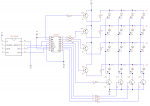procfanousek
Member
Hello,
I would like to ask for help. Can I wire a circuit like the one in the attached image? If yes, I cannot figure out what a code looks like if I want to multiplex LEDs in the matrix so that only one is "ON" at a time and to run various animate patterns. Could anybody be willing to explain it to me? Thank you very much for help. I can (almost) figure out doing it with two 74HC595 in cascade only.
I would like to ask for help. Can I wire a circuit like the one in the attached image? If yes, I cannot figure out what a code looks like if I want to multiplex LEDs in the matrix so that only one is "ON" at a time and to run various animate patterns. Could anybody be willing to explain it to me? Thank you very much for help. I can (almost) figure out doing it with two 74HC595 in cascade only.
Attachments
-
127.3 KB Views: 68



